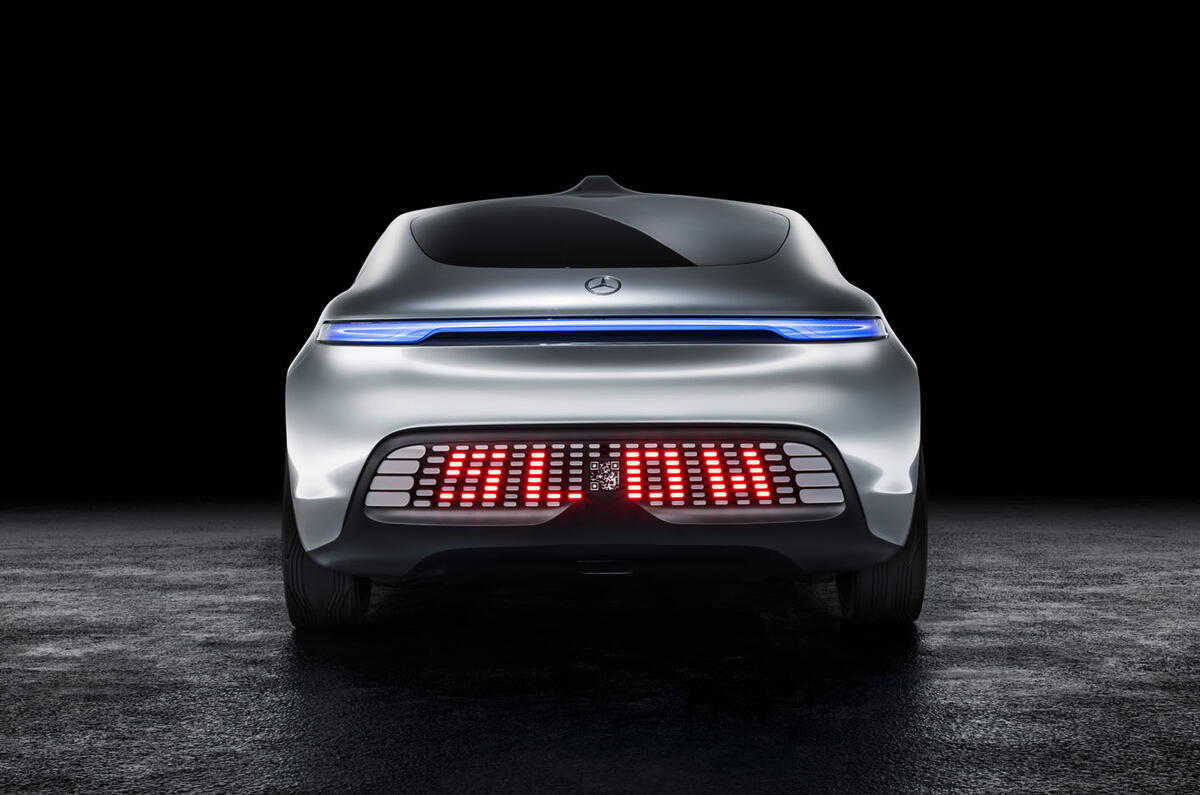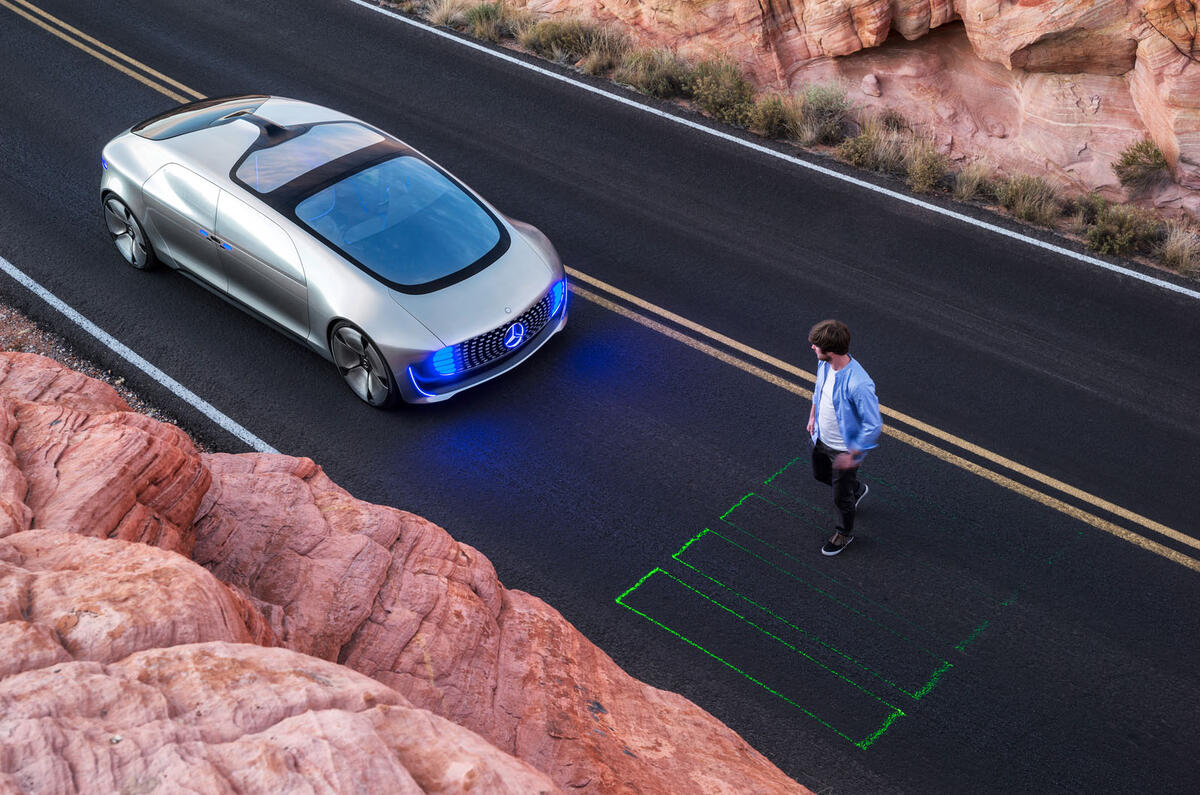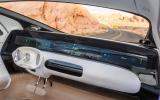The F015 Luxury in Motion concept is Mercedes-Benz’s vision for an autonomous car at the luxury end of the market, an Mercedes-Benz S-Class of the future that will have chauffeurs feeling nervous about long-term employment prospects.
It is a concept car in the truest sense and a radical design that embraces and exploits new technology in its powertrain, construction and, most importantly, the interior design and layout to rethink how we’ll use a car when we’re not concerning ourselves with driving it.
Indeed, as Mercedes boss Dieter Zetsche himself said at the F015’s unveiling earlier this year: “Anyone who focuses solely on the technology has not yet grasped how autonomous driving will change our society. The car is growing beyond its role as a mere means of transport and will ultimately become a mobile living space.”
To give an idea of its size, the F015 is slightly shorter than a long-wheelbase S-Class, but is a fair bit wider and also a touch taller. But the most radical difference is in the proportions; the F015 is a vast, streamlined monobox design instead of the three-box silhouette of an S-Class, all designed to maximise space in an interior that is all about being lounge-like rather than a cocooning driver’s car.
The F015 can be such a shape as there is no conventional engine in the bonnet, so the overhangs are ultra-short and the front and rear windscreens upright, allowing the bulk of the car’s footprint to be taken up with cabin space thanks to the 3610mm-long wheelbase, which is some 445mm longer than that of an Mercedes-Benz S-Class LWB.
It’s only really recognisable as a Mercedes-Benz from the outside by the shape of the front grille and the three-pointed star in the middle of it, again living up to its out-there concept car brief. But the most interesting part of this car is not as a purveyor of some future exterior design language, but that interior.
The theory of autonomous driving is all about giving time back to the driver. So this concept, as the S-Class of tomorrow, aims to show just what can be possible at the top end of a market of autonomous cars, where that time you get back from not driving really is treated as a luxury.
Enter the cabin for the first time and you’re struck by just how Mercedes has managed to so radically change something that’s usually so familiar, in terms of layout, materials and the absence of the usual ‘hard points’. It’s like one of those rooms they erect in IKEA with a clever, Tardis-like and minimalist use of space.
The four-door F015 does without conventional B-pillars, so access to the luxurious cabin is via a pair conventional front and a pair of rear-hinged doors.
Despite all that space, it has only got four seats; this is no MPV, remember. The seats swivel by 30deg when you open the doors to allow easy access, and can be put in two seating arrangements, either in two rows of two, or all facing one another with the front pair of seats swivelled around.
Enter the cabin and you'll nod with approval with the quality of the material selection; there are premium woods, leather, carpet, and metals, all seamlessly blending into one another in a flowing space.
Living alongside these luxurious materials are six touchscreens, one mounted at the front as a dashboard that can be controlled by gesture controls, another on the back wall, and then four more mounted into the doors. These screens allow the individual passengers to control everything from the infotainment options to the speed of the car itself, all by touch and swipe controls. Images from the outside world, or even further afield, can be displayed around the screens also, as can live TV pictures from sports games for a 360deg view of the action.
Seeing four seats facing one another in a car takes surprisingly little time to get used to. Once the doors are shut, the seatbelts are locked in and the car is moving, it all feels very normal. Indeed, the car feels trustworthy enough for you not to have to focus on what it is doing, and you can concentrate on that lost art of conversation with your fellow passengers.
It’s also fascinating how the concept of speed is taken out of the equation when you’re not behind the wheel and are getting on with something else; you’ve got the time back from the fact you’re being driven, so you don’t bat much of an eyelid at a traffic jam as you’ve got an environment and the tools to use the time productively.
Should you tire of being chauffeured around, then you can still drive the F105 yourself. The driver’s seat spins around to face the front, a steering wheel pops out the dashboard and there are pedals in the floor.
It’s worth noting that in spite of pushing the autonomous technology, Mercedes says it will never remove the ability for a driver to drive the car themselves, and it still wants to make all its future cars good to drive. Unlike Google, for example, which removes the driver and any kind of control completely from the equation.
Take control of the F015 and the LED lights in the grille shine white to show that a human is driving it; they are blue when the car is driving itself. When in its autonomous mode, it can do all manner of clever stuff, perhaps most intriguingly stopping when it sees pedestrians wanting to cross the road, then checking if it is safe for them to do so before projecting a zebra crossing onto the road and saying “please go ahead” through some external speakers. All very courteous.
Reading this all back, it does sound a bit far fetched. But then again, the F015 is supposed to be; it is a concept car, and one designed for a world we don’t currently live in. But there are still plenty more easter eggs in this car that hint at a less distant future.
The body of the F015 is constructed by a combination of carbonfibre-reinforced plastic, aluminium and high-strength steel, which insiders say hint at future production techniques for Mercedes bodies. The structure weighs around 40% less than the more conventional aluminium and high-strength steel structures in use today, and is also stronger.
And while the design and layout of the F015 may be some way into the future, the technology that allows it to drive on its own most certainly is not. This thing works already; it can safely and legally drive itself on public roads in places like California, one of four US states which has legislation to allow real-world trials of such cars.
The autonomous technology runs off a range of sensors and state-of-the-art stereo cameras to continually monitor the surrounding area. This kind of tech features on models today as small as the C-Class, allowing the car to drive and steer through stop-start traffic and park itself.
What’s different in the F105 is that the software that runs the hardware is newly developed. It features artificial intelligence to think how a human would think in certain unexpected situations, something that’s crucial if trust in autonomous cars is to develop.
The drivetrain that powers it also works, although it is one that relies on an as yet non-existent infrastructure. It is a plug-in hydrogen fuel cell electric powertrain, which has a total range of 684 miles, the latter 559 miles of which are from electricity generated by the fuel cell, and the first 125 miles from the lithium ion battery which can be inductive charged without the use of a cable.
Two electric motors with a combined 268bhp and 294lb ft drive the rear wheels, and a 0-62mph time of 6.7sec is quoted alongside a 124mph top speed. The hydrogen tanks are integrated into the floor to protect them from impacts.
The F015 is a true conversation starter for this future technology, which is already getting people debating all the merits or otherwise of autonomous driving. A key fact to remember is that Mercedes still wants you to drive the car if you so wish, but it also wants to give you the ability to use your time in the car in other ways.
Is it the future? I think so. Since when has progress and more choice been a bad thing?































Join the debate
Add your comment
Where do I put my canoe?
These self-driving cars, autonomous vehicles, are going to be suggested, then shoved down our throats. They are a totalitarian government's dream for control over us, our freedom of movement.
They will only go where they are told or allowed to go.
In the future, after insurance companies price the deplorables out of the market for having their own vehicle that they drive, it will become a social status to be able to drive your own vehicle.
I will fight this until I die. Look at how the government controls so much of our lives now!
You think this thing can just go for a ramble down a old logging road for a look-see?
See the future, with invisible bars all around you as you drive only to the destinations you are allowed by the authorities.
OJOV-V
A-pillar
Range is Everything
Bucharest to Salisbury is a trip of 1659 miles for my usual route. Non stop in this Mercedes F105 would be a comfortable 27 hours - arriving relatively refreshed - rather than washed out for 24 hs.
Interesting that the power
topsecret456987 wrote
I thought that was excessively high myself, and likely to be because it was human drivable.
I'd expect a purely driverless with 40% weight saving to be down around 50bhp. If you're being driven you don't need the fast acceleration, with rear facing seats you may not even want it.